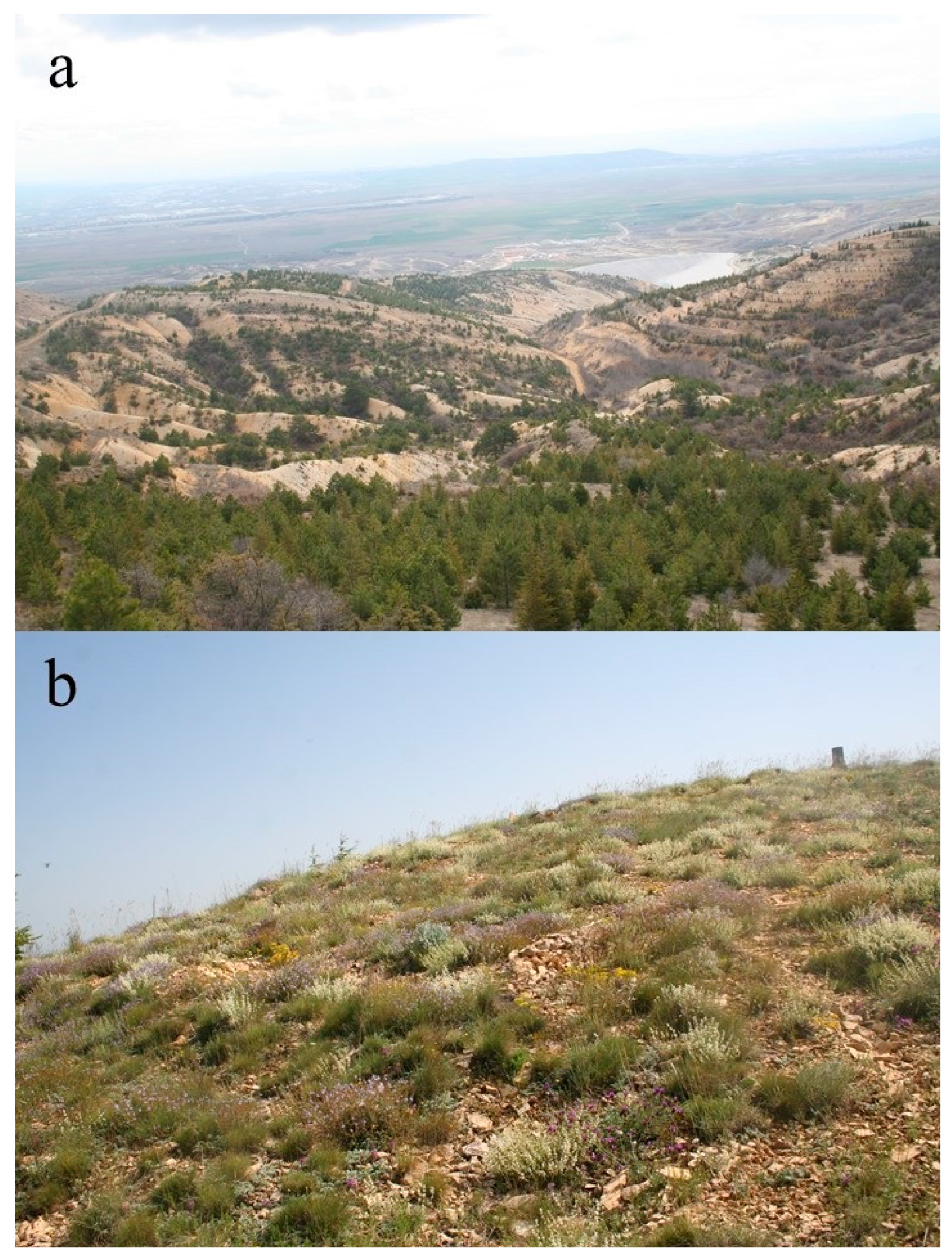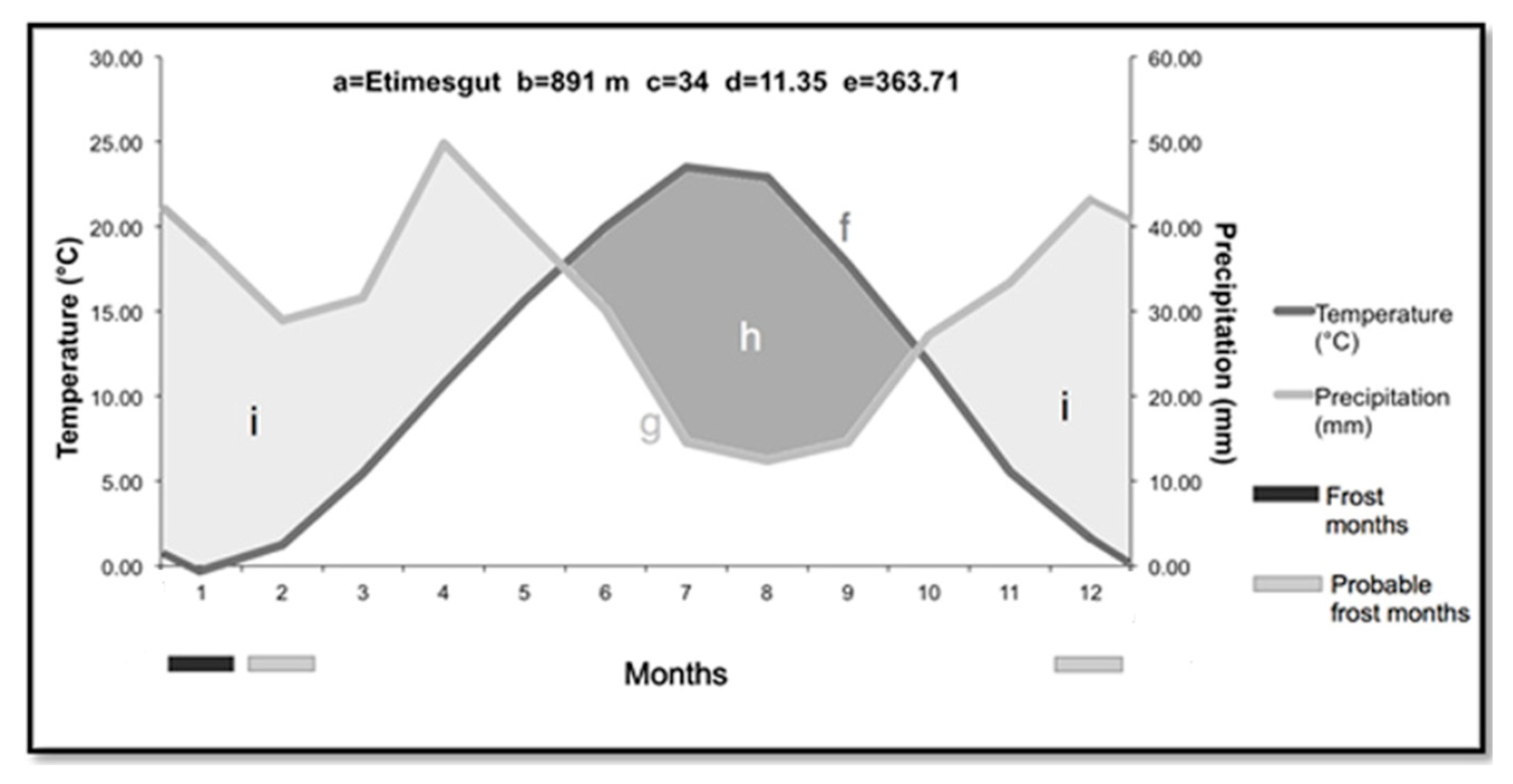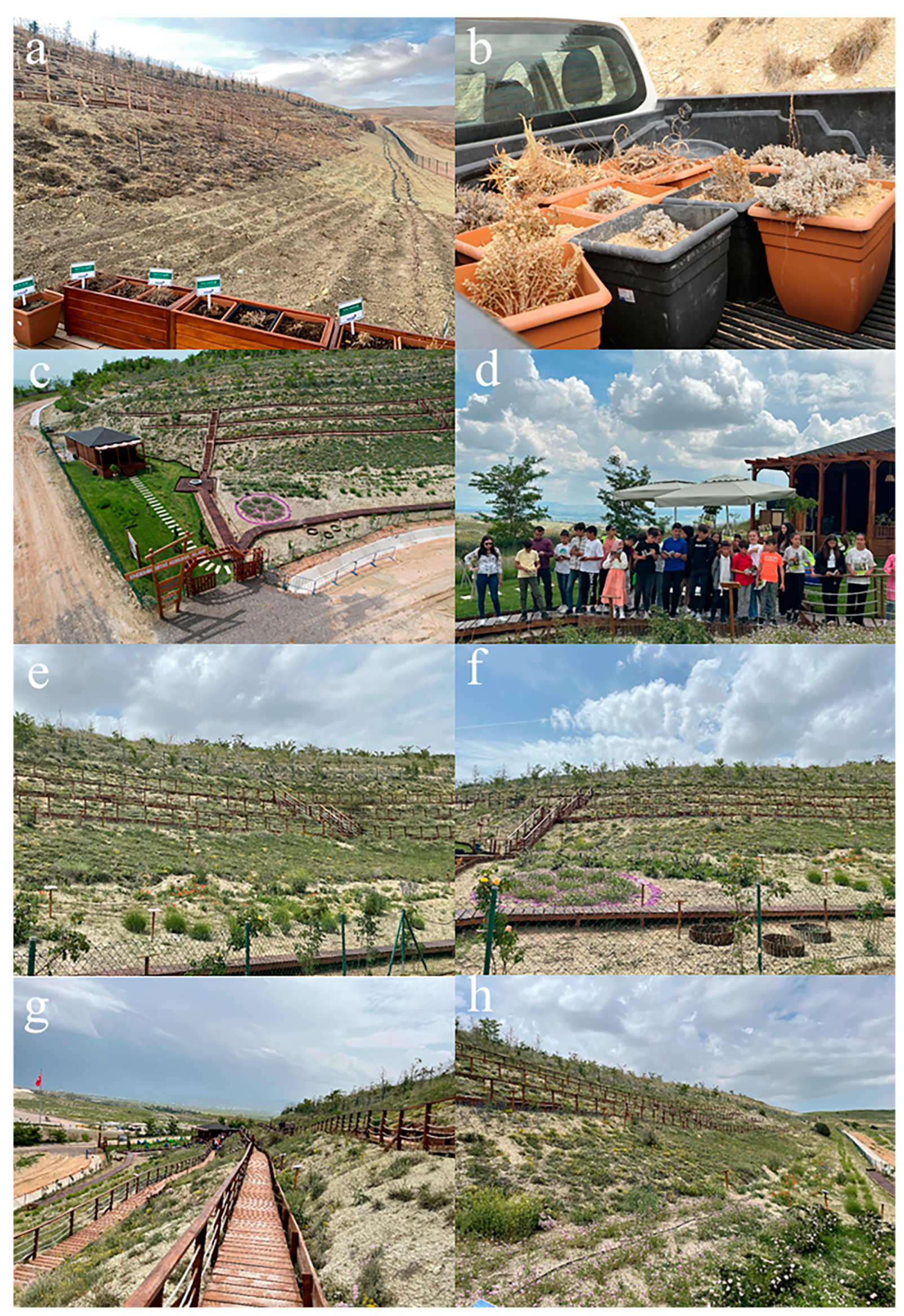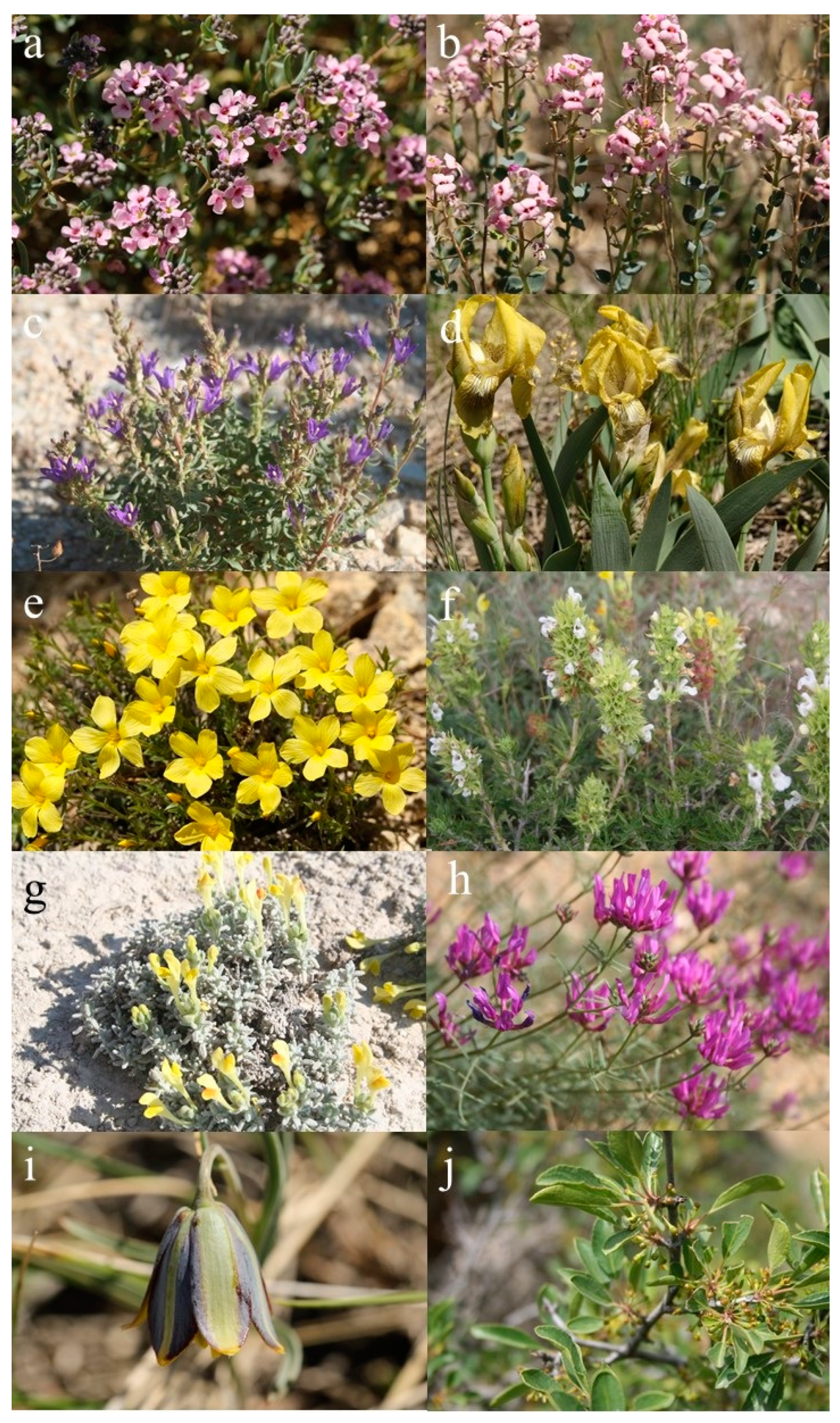Ex Situ and In Situ Conservation Approaches in Species-Rich Anatolian Steppe Ecosystem: A Case Study from Ankara, Türkiye
Abstract
1. Introduction
2. Material and Methods
2.1. Study Area
2.2. Target Plant Selection
2.3. In Situ Conservation
2.4. Ex Situ Conservation
2.5. Translocation Process
3. Results
4. Discussion and Conclusions
Supplementary Materials
Author Contributions
Funding
Institutional Review Board Statement
Informed Consent Statement
Data Availability Statement
Acknowledgments
Conflicts of Interest
References
- Sekercioglu, C.H. Ecosystem functions and services. In Conservation Biology for All, 1st ed.; Sodhi, N.S., Ehrlich, P.R., Eds.; Oxford University Press Inc.: New York, NY, USA, 2010; pp. 45–72. [Google Scholar]
- FAO. The State of the World’s Biodiversity for Food and Agriculture; FAO Commission on Genetic Resources for Food and Agriculture Assessments; FAO: Rome, Italy, 2019. [Google Scholar]
- Corlett, R.T. A Bigger Toolbox: Biotechnology in Biodiversity Conservation. Trends Biotechnol. 2017, 35, 55–65. [Google Scholar] [CrossRef]
- Cuttelod, A.; García, N.; Abdul Malak, D.; Temple, H.; Katariya, V. The 2008 Review of the IUCN Red List of Threatened Species; Vié, J.-C., Hilton-Taylor, C., Stuart, S.N., Eds.; IUCN: Gland, Switzerland, 2008; p. 1. [Google Scholar]
- Reed, B.M.; Sarasan, V.; Kane, M.; Bunn, E.; Pence, V.C. Biodiversity conservation and conservation biotechnology tools. In Vitro Cell. Dev. Biol.-Plant 2011, 47, 1–4. [Google Scholar] [CrossRef]
- Sarasan, V.; Cripps, R.; Ramsay, M.M.; Atherton, C.; Mcmichen, M.; Prendergast, G.; Rowntree, J.K. Conservation in vitro of threatened plants—Progress in the past decade. In Vitro Cell. Dev. Biol.-Plant 2006, 42, 206–214. [Google Scholar] [CrossRef]
- Foggi, B.; Viciani, D.; Baldini, R.M.; Carta, A.; Guidi, T. Conservation assessment of the endemic plants of the Tuscan Archipelago, Italy. Oryx 2014, 49, 118–126. [Google Scholar] [CrossRef]
- Işık, K. Rare and endemic species: Why are they prone to extinction? Turk. J. Bot. 2011, 35, 411–417. [Google Scholar] [CrossRef]
- Coelho, N.; Gonçalves, S.; Romano, A. Endemic plant species conservation: Biotechnological approaches. Plants 2020, 9, 345. [Google Scholar] [CrossRef]
- Sharrock, S.; Ulian, T. Plant Diversity Conservation Challenges and Prospects—The Perspective of Botanic Gardens and the Millennium Seed Bank. Plants 2021, 10, 2371. [Google Scholar] [CrossRef] [PubMed]
- Maxted, N.; Ford-Lloyd, B.V.; Hawkes, J.G. Complementary conservation strategies. In Plant Genetic Conservation: The In Situ Approach; Maxted, N., Ford-Lloyd, B.V., Hawkes, J.G., Eds.; Chapman and Hall: London, UK, 1997; Chapter 2; p. 15. [Google Scholar]
- Fenu, G.; Bacchetta, G.; Christodoulou, C.S.; Cogoni, D.; Fournaraki, C.; Giusso del Galdo, G.; Gotsiou, P.; Kyratzis, A.; Piazza, C.; Vicens, M.; et al. A common approach to the conservation of threatened island vascular plants: First results in the Mediterranean basin. Diversity 2020, 12, 157. [Google Scholar] [CrossRef]
- Parolly, G. The high mountain vegetation of Türkiye—A state of the art report, including a first annotated conspectus of the major syntaxa. Turk. J. Bot. 2004, 28, 39–63. [Google Scholar]
- Güner, A.; Aslan, S.; Babaç, M.T.; Vural, M.; Ekim, T. Türkiye Bitkileri Listesi (Damarlı Bitkiler); Nezahat Gökyiğit Botanik Bahçesi: Istanbul, Türkiye, 2012; pp. 1–1290. [Google Scholar]
- Davis, P.H. Distribution patterns in Anatolia with particular reference to endemism. In Plant Life of South West ASIA; Davis, P.H., Harper, P.C., Hedge, I.C., Eds.; Bot. Soc. Edinburgh: Edinburgh, UK, 1971; pp. 15–28. [Google Scholar]
- Takhtajan, A.L. Floristic Regions of the World. (Translation from Russian by TJ Crovello); University of California Press: Berkeley, CA, USA, 1986. [Google Scholar]
- Mittermeier, R.A.; Gil, P.R.; Hoffmann, M.; Pilgrim, J.; Brooks, T.; Mittermeier, C.G.; Lamoreux, J.; Da Fonseca, G.A.B. Hotspots Revisited: Earth’s Biologically Richest and Most Endangered Terrestrial Ecoregions; CEMEX: Mexico City, Mexico, 2004. [Google Scholar]
- Noroozi, J.; Zare, G.; Sherafati, M.; Mahmoodi, M.; Moser, D.; Asgarpour, Z.; Schneeweiss, G.M. Patterns of Endemism in Türkiye, the Meeting Point of Three Global Biodiversity Hotspots, Based on Three Diverse Families of Vascular Plants. Front. Ecol. Evol. 2019, 7, 159. [Google Scholar] [CrossRef]
- Kaya, Z.; Raynal, D.J. Biodiversity and conservation of Turkish forests. Boil. Conserv. 2001, 97, 131–141. [Google Scholar] [CrossRef]
- Manafzadeh, S.; Staedler, Y.M.; Conti, E. Visions of the Past and Dreams of the Future in the Orient: The Irano-Turanian Region from Classical Botany to Evolutionary Studies. Biol. Rev. 2017, 92, 1365–1388. [Google Scholar] [CrossRef]
- Ambarlı, S.; Zeydanlı, U.S.; Balkı, Ö.; Aslan, S.; Karaçetin, E.; Sözen, M.; Ilgaz, Ç.; Gürsoy Ergen, A.; Lise, Y.; Demirbas Çağlayan, S.; et al. An overview of biodiversity and conservation status of steppes of the Anatolian Biogeographical Region. Biodivers. Conserv. 2016, 25, 2491–2519. [Google Scholar] [CrossRef]
- Celep, F.; Doğan, M.; Kahraman, A. Re-evaluated conservation status of Salvia (sage) in Türkiye I: The Mediterranean and the Aegean geographic regions. Turk. J. Bot. 2010, 34, 201–214. [Google Scholar]
- Kahraman, A.; Bagherpour, S.; Karabacak, E.; Doğan, M.; Doğan, H.M.; Uysal, İ.; Celep, F. Reassessment of conservation status of the genus Salvia (Lamiaceae) in Türkiye II. Turk. J. Bot. 2012, 36, 103–124. [Google Scholar]
- Eker, İ.; Vural, M.; Aslan, S. Ankara İli’nin Damarlı bitki çeşitliliği ve korumada öncelikli taksonları. Bağbahçe Bilim Derg. 2015, 2, 57–114. [Google Scholar]
- Akman, Y. İklim ve Biyoiklim; Mühendislik Serisi 103; Palme Yayın Dağıtım: Ankara, Turkey, 1990. [Google Scholar]
- Cireli, B.; Öztürk, M.; Seçmen, Ö. Bitki Ekolojisi Uygulamaları; Ege Üniversitesi Fen Fakültesi Kitaplar Serisi No: 50; Ege Üniversitesi Matbaası: İzmir, Turkey, 1973. [Google Scholar]
- Töre, D.; Erik, S. The Flora of Bağlıca Campus of Başkent University (Ankara). Hacet. J. Biol. Chem. 2012, 40, 267–291. [Google Scholar]
- Davis, P.H. Flora of Türkiye and the East Aegean Islands; Edinburgh University Press: Edinburgh, UK, 1965; Volume 1. [Google Scholar]
- Davis, P.H. Flora of Türkiye and the East Aegean Islands; Edinburgh University Press: Edinburgh, UK, 1967; Volume 2. [Google Scholar]
- Davis, P.H. Flora of Türkiye and the East Aegean Islands; Edinburgh University Press: Edinburgh, UK, 1970; Volume 3. [Google Scholar]
- Davis, P.H. Flora of Türkiye and the East Aegean Islands; Edinburgh University Press: Edinburgh, UK, 1972; Volume 4. [Google Scholar]
- Davis, P.H. Flora of Türkiye and the East Aegean Islands; Edinburgh University Press: Edinburgh, UK, 1975; Volume 5. [Google Scholar]
- Davis, P.H. Flora of Türkiye and the East Aegean Islands; Edinburgh University Press: Edinburgh, UK, 1978; Volume 6. [Google Scholar]
- Davis, P.H. Flora of Türkiye and the East Aegean Islands; Edinburgh University Press: Edinburgh, UK, 1982; Volume 7. [Google Scholar]
- Davis, P.H. Flora of Türkiye and the East Aegean Islands; Edinburgh University Press: Edinburgh, UK, 1984; Volume 8. [Google Scholar]
- Davis, P.H. Flora of Türkiye and the East Aegean Islands; Edinburgh University Press: Edinburgh, UK, 1985; Volume 9. [Google Scholar]
- Davis, P.H. Flora of Türkiye and the East Aegean Islands; Edinburgh University Press: Edinburgh, UK, 1988; Volume 10. [Google Scholar]
- Ekim, T.; Koyuncu, M.; Vural, M.; Duman, H.; Aytaç, Z.; Adıgüzel, N. Red Data Book of Turkish Plants (Pteridophyta and Spermatophyta); Turkish Association for the Conservation of Nature & Van Centennial University: Ankara, Türkiye, 2000. (In Turkish) [Google Scholar]
- IUCN. The IUCN Red List of Threatened Species. Version 2019-2. 2020. Available online: http://www.iucnredlist.org (accessed on 15 May 2024).
- Ayyıldız, G.; Yıldırım, M.; Keser, A.M.; Yaprak, A.E.; Tuğ, G.N. Reclassifying the threat categories of two rare plant species endemic to Central Anatolia. Hacet. J. Biol. Chem. 2024, 52, 85–95. [Google Scholar] [CrossRef]
- Ayyıldız, G. Aysantı Beli (Ayaş-Ankara) Florasının Tehdit Altındaki Türleri (269492). Master’s Thesis, Ulusal Tez Merkezi, Ankara, Turkey, 2010. [Google Scholar]
- Subaşı, Ü. Ankara Province Ayas Bluebell (Campanula Damboldtiana) Species Conservation Action Plan; Ministry of Forestry and Water Affairs, General Directorate of Nature Protection and National Parks, IXth Regional Directorate-Ankara Branch Office: Ankara, Turkey, 2017. [Google Scholar]
- Yıldırım, M.; Ayyıldız, G.; Keser, A.M.; Tuğ, G.N.; Yaprak, A.E. Current population sizes, distribution areas and re-evaluated IUCN categories of rare and endemic species from Central Anatolia, Turkey: Salsola grandis, Scutellaria yildirimlii and Sideritis gulendamii. Biyol. Çeşitlilik Koruma 2019, 12, 151–160. [Google Scholar] [CrossRef]
- Yılmaz, M.; İdman, Ö.D.M. Conservation and Landscape Evaluation of some Endangered species in Türkiye. Bahçe 2024, 53, 1–9. [Google Scholar] [CrossRef]
- Hamzaoğlu, E.; Koç, M. Chorological contributions for some narrow-range endemic plant taxa in Turkey. Anatol. J. Bot. 2020, 4, 96–99. [Google Scholar] [CrossRef]
- Godefroid, S.; Piazza, C.; Rossi, G.; Buord, S.; Stevens, A.-D.; Aguraiuja, R.; Cowell, C.; Weekley, C.W.; Vogg, G.; Iriondo, J.M.; et al. How successful are plant species reintroductions? Biol. Conserv. 2011, 144, 672–682. [Google Scholar] [CrossRef]
- Liu, H.; Ren, H.; Liu, Q.; Wen, X.; Maunder, M.; Gao, J. Translocation of threatened plants as a conservation measure in China. Conserv. Biol. 2015, 29, 1537–1551. [Google Scholar] [CrossRef] [PubMed]
- Commander, L.E.; Coates, D.J.; Broadhurst, L.; Offord, C.A.; Makinson, R.O.; Matthes, M. (Eds.) Guidelines for the Translocation of Threatened Plants in Australia; Australian Network for Plant Conservation: Canberra, Australia, 2018. [Google Scholar]
- Antonelli, A.; Fry, C.; Smith, R.J.; Simmonds, M.S.J.; Kersey, P.J.; Pritchard, H.W.; Abbo, M.S.; Acedo, C.; Adams, J.; Ainsworth, A.M.; et al. State of the World’s Plants and Fungi 2020; Royal Botanic Gardens, Kew: London, UK, 2020. [Google Scholar]
- Werden, L.K.; Sugii, N.C.; Weisenberger, L.; Keir, M.J.; Koob, G.; Zahawi, R.A. Ex situ conservation of threatened plant species in island biodiversity hotspots: A case study from Hawai’i. Biol. Conserv. 2020, 243, 108435. [Google Scholar] [CrossRef]
- Cogoni, D.; Fenu, G.; Concas, E.; Bacchetta, G. The effectiveness of plant conservation measures: The Dianthus morisianus reintroduction. Oryx 2013, 47, 203–206. [Google Scholar] [CrossRef]
- Fenu, G.; Calderisi, G.; Borši’c, I.; Bou Dagher Kharrat, M.; García Fernández, A.; Kahale, R.; Panitsa, M.; Cogoni, D. Translocations of threatened plants in the Mediterranean Basin: Current status and future directions. Plant Ecol. 2023, 224, 765–775. [Google Scholar] [CrossRef]
- Ketenoğlu, O.; Vural, M.; Kurt, L.; Körüklü, T. Vejetasyon. In Resimli Türkiye Florası; Güner, A., Ekim, T., Eds.; Ali Nihat Gökyigit Vakfı, Flora Araştırmaları Derneği and Türkiye İş Bankası Kültür Yayınları yayını: Istanbul, Türkiye, 2014; Volume 1, pp. 163–243. [Google Scholar]
- Kürschner, H. The subalpine thorn-cushion formations of western South Asia: Ecology, structure and zonation. Proc. R. Soc. Edinb. 1986, 89B, 169–179. [Google Scholar] [CrossRef]
- Kürschner, H.; Parolly, G. The central Anatolian steppe. In Eurasian Steppes. Ecological Problems and Livelihoods in a Changing World; Werger, M.J.A., van Staalduinen, M.A., Eds.; Springer: Dodrecht, The Netherlands, 2012; pp. 149–171. [Google Scholar]
- Türkiye Cumhuriyeti Çevre, Şehircilik ve İklim Değişikliği Bakanlığı. Korunan Alanlar. Available online: https://cevreselgostergeler.csb.gov.tr/korunan-alanlar-i-85778#:~:text=(3)%20Toplam%20hesaplamalarda%20y%C3%BCzdeler%2C,77.998.600%20hektar%20esas%20al%C4%B1nm%C4%B1%C5%9Ft%C4%B1r (accessed on 27 February 2024).
- Özhatay, N.; Byfield, A.; Atay, S. Türkiye’nin 122 Önemli Bitki Alanı (Important Plant Areas in Turkey: 122 Key Botanical Sites); WWF-Türkiye (Doğal Hayatı Koruma Vakfı): İstanbul, Turkey, 2008. [Google Scholar]
- Erik, S.; Tarıkahya, B. Türkiye Florası üzerine. Kebikeç (İnsan Bilim. Kaynak Araşt. Derg.) 2004, 17, 139–163. [Google Scholar]
- Ali Nihat Gökyiğit Botanik Bahçesi ve Uygulama ve Araştırma Merkezi. Available online: https://botbamer.artvin.edu.tr/ (accessed on 27 February 2024).





Disclaimer/Publisher’s Note: The statements, opinions and data contained in all publications are solely those of the individual author(s) and contributor(s) and not of MDPI and/or the editor(s). MDPI and/or the editor(s) disclaim responsibility for any injury to people or property resulting from any ideas, methods, instructions or products referred to in the content. |
© 2024 by the authors. Licensee MDPI, Basel, Switzerland. This article is an open access article distributed under the terms and conditions of the Creative Commons Attribution (CC BY) license (https://creativecommons.org/licenses/by/4.0/).
Share and Cite
Duman, H.; Doğan, M.; Atlı, Ö.; Celep, F. Ex Situ and In Situ Conservation Approaches in Species-Rich Anatolian Steppe Ecosystem: A Case Study from Ankara, Türkiye. Ecologies 2024, 5, 664-678. https://doi.org/10.3390/ecologies5040039
Duman H, Doğan M, Atlı Ö, Celep F. Ex Situ and In Situ Conservation Approaches in Species-Rich Anatolian Steppe Ecosystem: A Case Study from Ankara, Türkiye. Ecologies. 2024; 5(4):664-678. https://doi.org/10.3390/ecologies5040039
Chicago/Turabian StyleDuman, Hayri, Murat Doğan, Özge Atlı, and Ferhat Celep. 2024. "Ex Situ and In Situ Conservation Approaches in Species-Rich Anatolian Steppe Ecosystem: A Case Study from Ankara, Türkiye" Ecologies 5, no. 4: 664-678. https://doi.org/10.3390/ecologies5040039
APA StyleDuman, H., Doğan, M., Atlı, Ö., & Celep, F. (2024). Ex Situ and In Situ Conservation Approaches in Species-Rich Anatolian Steppe Ecosystem: A Case Study from Ankara, Türkiye. Ecologies, 5(4), 664-678. https://doi.org/10.3390/ecologies5040039





